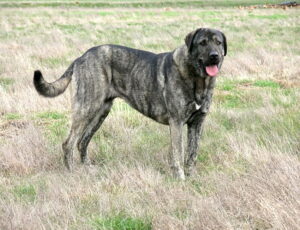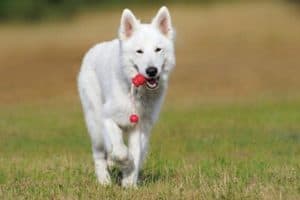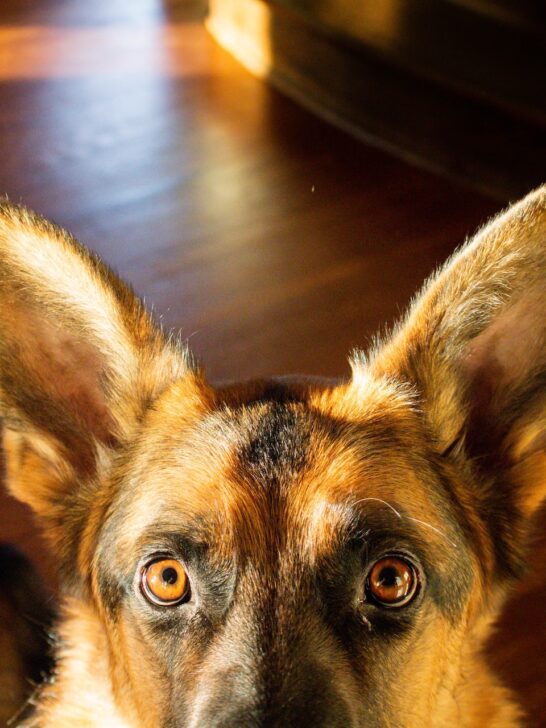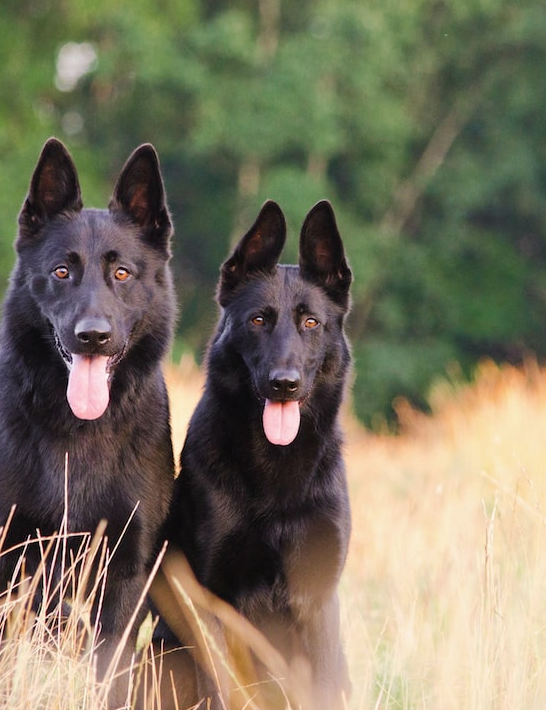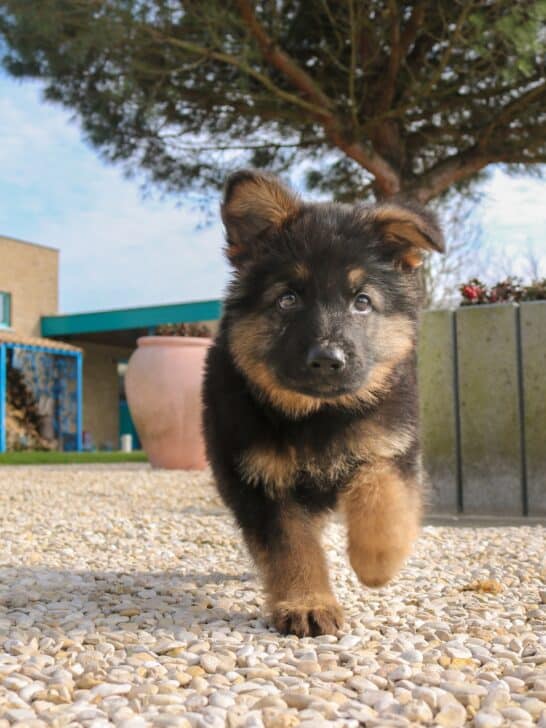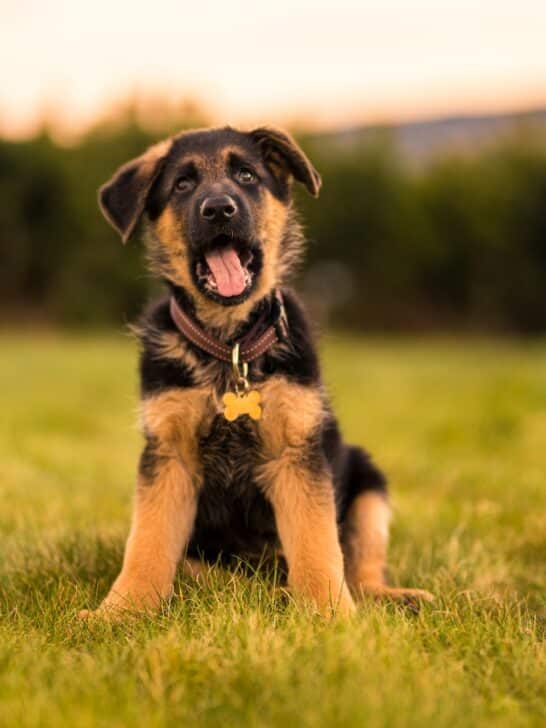Training Your German Shepherd Puppy
Engaging with a lovable, energetic German Shepherd puppy can be a deeply rewarding experience for dog enthusiasts. With their undeniable intelligence and inherent loyalty, these puppies are born ready to learn and eager to please. The early months of your German Shepherd’s life are essential to shape its behavior and instill lasting habits that will benefit you and your furry companion.
The key to raising a well-behaved, obedient German Shepherd lies in the effectiveness of its foundational training. This comprehensive guide covers the critical aspects of training, from teaching basic commands to working on more advanced skills, ensuring that your German Shepherd grows into a confident, well-mannered adult.
Below, you will find valuable insights into training your German Shepherd puppy in an enjoyable and effective way. Read on for tips and advice that will help you establish a solid foundation for your puppy’s lifelong learning and development.
Key Takeaways:
- Understanding your German Shepherd’s unique temperament is vital for successful training, as they can be strong-willed and assertive but also highly trainable with a strong work ethic.
- Essential commands for initial obedience training include “sit,” “stay,” “down,” and “come.” Consistency and positive reinforcement are crucial in teaching these commands.
- Socialization is an integral part of raising a well-behaved and confident dog. Gradual exposure, polite greetings, observing body language, establishing boundaries, and monitoring playtime are essential strategies for effective socialization.
- Housebreaking a puppy involves teaching them appropriate bathroom habits, with techniques such as ensuring a routine, selecting a designated elimination spot, using a cue word, rewarding success, being vigilant, and managing accidents.
- Instilling proper leash behavior is essential for enjoyable walks and maintaining control. Introduce the collar and leash, practice indoors, teach the “heel” command, gradually increase difficulty, redirect pulling behavior, and use proper equipment for the best results.
Understanding Your German Shepherd’s Temperament
Getting to know your German Shepherd’s unique personality is crucial for successful training. These intelligent dogs are known for their strong work ethic and willingness to learn, making them highly trainable. However, they can also be strong-willed and assertive, requiring patience and consistency from their handlers.
Here are some key steps to help you gain insight into your German Shepherd’s unique personality:
- Observe your puppy’s behavior. Pay close attention to how your puppy responds to different environments, people, and other animals. Note any patterns or consistencies in their reactions to stimuli, such as excitement, fear, or aggression.
- Socialize your puppy early. Expose your German Shepherd to various situations, people, and pets from a young age. This will help you identify areas where your puppy may need extra guidance or support while also promoting their adaptability and confidence.
- Consult breed-specific resources. Researching the typical characteristics of German Shepherds can provide valuable context for understanding your puppy’s behavior.
- Seek professional guidance. If you’re unsure about your puppy’s temperament or need assistance with training strategies, consult a professional dog trainer or behaviorist who specializes in working with German Shepherds.
Remember that each dog is an individual, and understanding your puppy’s temperament will enable you to adapt your training methods accordingly.
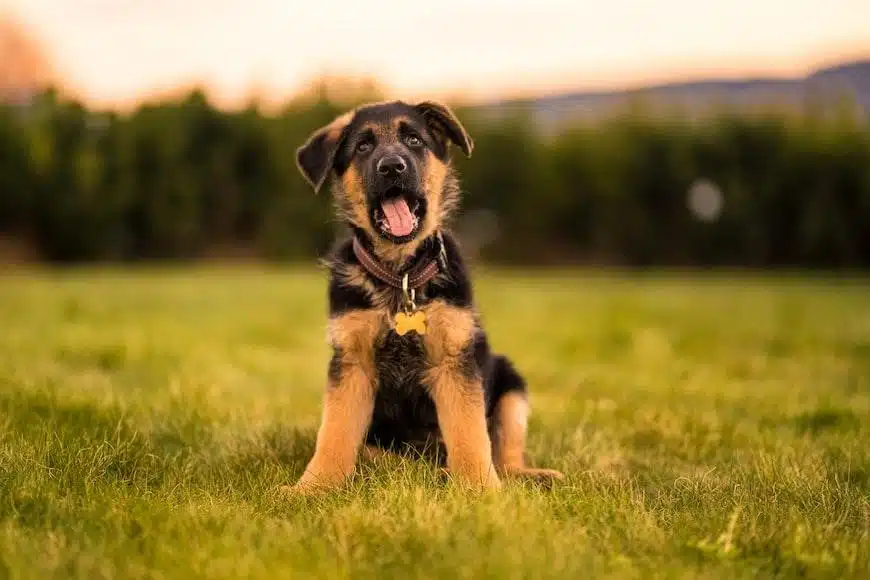
Essential Commands for Initial Obedience Training
The first step in obedience training is teaching your German Shepherd essential commands such as “sit,” “stay,” “down,” and “come.” These foundational skills promote good behavior and create a bond of trust between you and your puppy.
Sit
The “sit” command is a fundamental skill that helps establish your leadership and lays the groundwork for more advanced commands.
To teach this, hold a treat above your puppy’s nose and slowly move it back toward its tail. As their head follows the treat, their bottom should naturally lower into a sitting position. Say “sit” as they do so, and reward them with the treat and praise.
Stay
Teaching your German Shepherd puppy to “stay” is crucial for ensuring their safety and teaching self-control.
Once your puppy has mastered “sit,” ask them to sit and then say “stay” while holding your hand up like a stop sign. Take a step back and wait for a few seconds before returning to your dog’s side. Reward them if they remain in place; if not, calmly repeat the process.
Down
The “down” command helps reinforce submission and is useful in situations where your dog needs to be calm or still.
To teach this, hold a treat near your puppy’s nose and slowly lower it to the ground while saying “down.” As their head follows the treat, their body should lower into a lying position. Reward them with the treat and praise once they’re completely down.
Come
The “come” command is essential for maintaining control of your German Shepherd and ensuring its safety when off-leash.
Begin by placing your puppy on a long lead. Walk away from them and then say “come,” using an enthusiastic tone while gently tugging on the lead. Praise and reward your dog as soon as they come towards you.
Begin with short, focused training sessions, gradually increasing the difficulty as your puppy masters each command. Consistency is vital, so practice regularly and remember to use positive reinforcement, such as treats and praise, to encourage desired behaviors.
Avoid punishing your dog for disobedience; instead, redirect their attention to the correct action. If the training session isn’t going smoothly and you start getting impatient, take a break and resume training later.
Socialization: The Key to a Well-Behaved Dog
Creating positive social experiences for your German Shepherd from a young age is crucial for their development into a well-behaved, confident, and friendly adult dog. Here are some additional tips and strategies to enhance your puppy’s socialization journey:
- Gradual exposure. Introduce your German Shepherd puppy to new experiences at a comfortable pace, ensuring that each encounter is positive and non-threatening. The socialization window for puppies closes at 12 to 16 weeks of life, so make sure you don’t miss it.
- Encourage polite greetings. Teach your puppy to greet people and other dogs calmly and politely without jumping or barking. Reward them with treats and praise when they exhibit appropriate behavior during interactions.
- Observe body language. Pay close attention to your puppy’s body language during social encounters. If they appear fearful or anxious, gently remove them from the situation and try again later, gradually building their confidence.
- Establish boundaries. While socialization is vital, it’s also crucial to teach your German Shepherd appropriate boundaries, such as not pulling on the leash or invading personal space.
- Monitor playtime. Supervise play sessions with other dogs to ensure that interactions remain safe and positive. Step in if play becomes too rough or aggressive, redirecting your puppy’s energy towards more appropriate behavior.
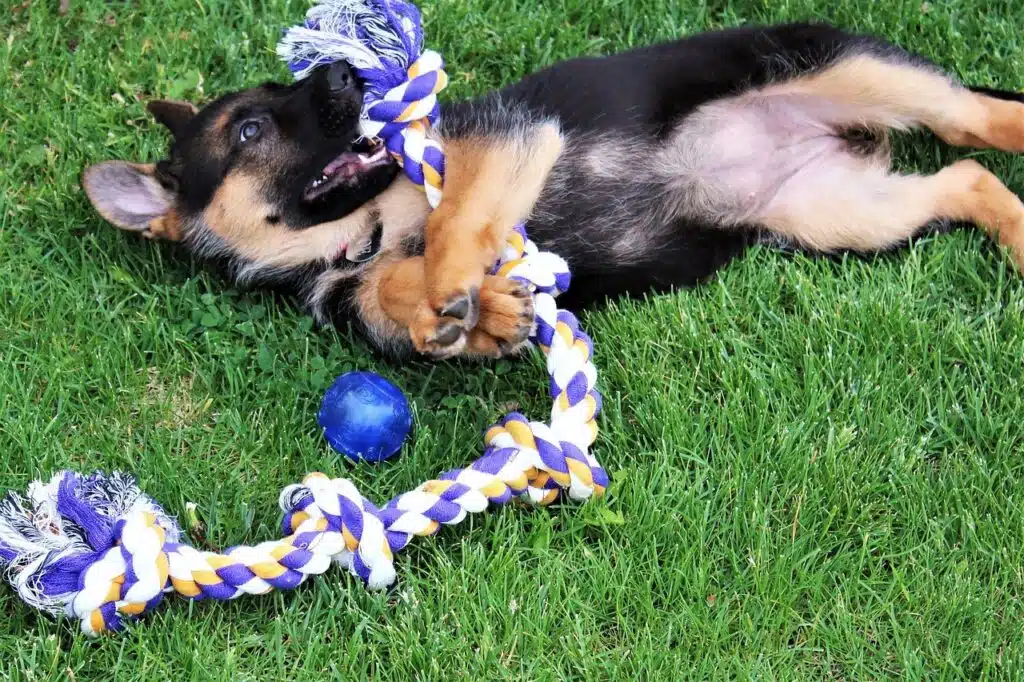
Housebreaking Your Puppy: Tips and Techniques
Housebreaking a puppy is the process of training them to eliminate waste (urinate and defecate) in a designated area, usually outdoors. The goal is to teach your puppy good bathroom habits, helping them understand when and where it is appropriate to eliminate.
Housebreaking is essential to raising a well-mannered and hygienic dog, ensuring that they can coexist harmoniously in a household environment. To effectively housebreak your German Shepherd puppy, implement these techniques to create a consistent, supportive environment that fosters success:
- Ensure a routine. Establish a schedule for feeding, playtime, and potty breaks. Your puppy will quickly learn to associate specific times of day with these activities, making housebreaking smoother and more predictable.
- Choose an appropriate elimination spot. Select a designated area outside where you want your puppy to eliminate. Always take them to this spot during potty breaks so they can associate it with the act of going to the bathroom. Remember that while a relatively small area might work well for small-breed dogs, larger breeds, such as German Shepherds, will need more space.
- Use a cue word or phrase. When your puppy starts to eliminate, use a cue word or phrase like “go potty” or, as the Australians say, “busy, busy.” This will help them associate the command with the action, making it easier for you to prompt them in the future.
- Reward success. Nothing says “job well done” better than a reward! Praise and reward your puppy with treats and affection when they successfully “do their business” in the designated area. Positive reinforcement will encourage them to continue this good behavior.
- Be vigilant. Keep a close eye on your puppy for signs they need to go, such as sniffing, circling, or whining. Take them outside immediately if you notice any of these cues.
- Manage accidents. If your puppy has an accident indoors, clean the area thoroughly with an enzymatic cleaner to remove any lingering odors that may attract them to the same spot again. Avoid scolding or punishing your puppy for accidents; instead, focus on reinforcing positive behaviors and sticking to the established routine.
Remember that patience is vital during the housebreaking process. It may take several weeks for your German Shepherd puppy to become fully housebroken.
Instilling Proper Leash Behavior
Walking on a leash is an essential skill for puppies, which can start learning as early as eight weeks old. Good leash behavior includes walking calmly by the owner’s side without pulling, lunging, or excessively sniffing during a walk. A well-behaved dog on a leash maintains a loose leash with no tension and follows the owner’s pace and direction.
To help your German Shepherd puppy develop proper leash manners, follow these steps and tips:
- Introduce the collar and leash. Allow your puppy to become comfortable with wearing a collar and leash by introducing them gradually. Let them wear the collar around the house and then attach the leash briefly while supervising.
- Practice indoors. Before venturing outside, practice walking on a leash indoors or in your backyard. Encourage your puppy to follow you while maintaining a loose leash, rewarding them with treats and praise for proper behavior.
- Teach the “heel” command. Teaching your German Shepherd to “heel” can be invaluable for maintaining control during walks. Hold a treat near your left side to train this command and encourage your dog to follow while remaining close to you. As they walk beside you, say “heel” and reward them with the treat.
- Gradually increase difficulty. Start with short walks in low-distraction environments before gradually increasing the length of walks and introducing more distractions. This will help build your puppy’s confidence.
- Redirect pulling behavior. If your German Shepherd begins to pull on the leash, stop walking immediately, and change direction. This teaches them that pulling will not result in forward progress.
- Use proper equipment. Selecting the right collar or harness for your German Shepherd is essential for promoting good leash behavior. Options like front-clip harnesses or head collars can provide additional control without causing discomfort.
By instilling good leash behavior early in your German Shepherd’s life, you’ll ensure enjoyable walks for both you and your furry companion while keeping them safe and well-mannered in various environments.
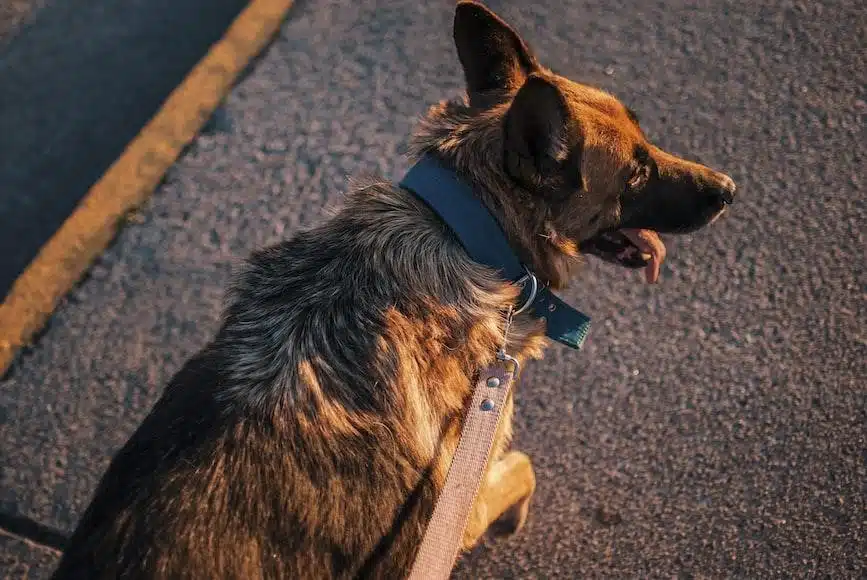
In Conclusion
Training a German Shepherd puppy requires patience, consistency, and a keen understanding of its unique temperament. Basic training, encompassing essential commands, socialization, and housebreaking techniques, forms the foundation for a well-behaved, confident, and sociable adult dog. Leash training is equally significant, ensuring safety and manageability during walks.
Each of your training efforts should be a positive, rewarding experience, thereby fostering trust and cooperation. With time, dedication, and positive reinforcement, your German Shepherd will grow into a loyal, obedient, and loving companion, reflecting the care and effort invested in their early training.
Remember, the bond you create during this journey is as important as the training itself. Good luck!














